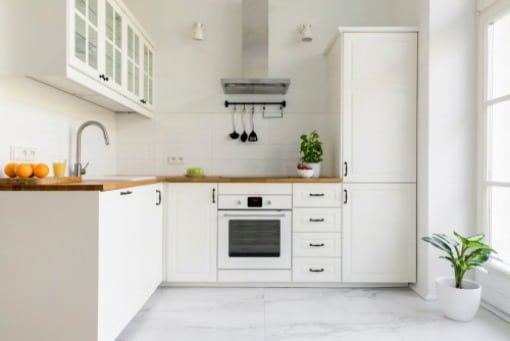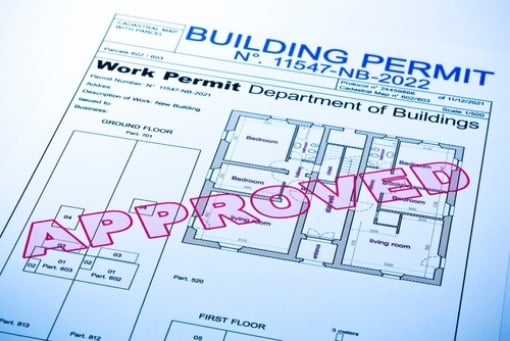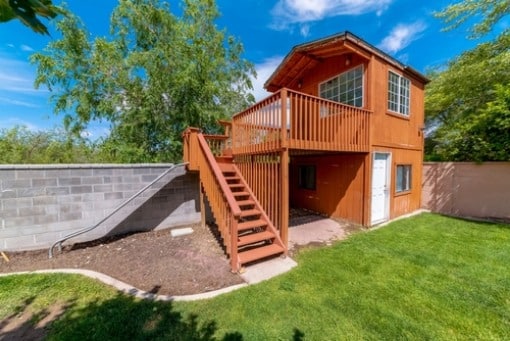What Is An Accessory Dwelling Unit?
Have you ever wondered how to maximize your property’s potential while adding function and value? Accessory Dwelling Units, or ADUs, are an innovative solution growing in popularity.
This article comprehensively explains what an ADU is, its benefits to homeowners, its drawbacks, and other essential details you need to know.
Curious yet? Discover whether building an ADU might be the next step on your home improvement journey.
Meeting the Housing or Privacy Needs of the Family
An ADU, or accessory dwelling unit, can be the perfect solution for meeting your family’s housing or privacy needs. Whether you have a young adult seeking independence or an elderly family member who requires more supervision and freedom, an ADU offers a separate living space on your property.
This secondary dwelling unit provides privacy and independence while keeping your loved ones nearby. With living, sleeping, cooking, and bathroom facilities all included in an ADU, it becomes an auxiliary residential unit that can cater to the specific needs of your family members.
Adding an ADU enhances their quality of life and simplifies yours by providing a convenient housing option on your property.
An ADU can also open up financial opportunities through rental income potential or increased property value.

What Is The Difference Between An ADU And A Guest House?
An ADU, or Accessory Dwelling Unit, is designed for long-term, everyday living with a separate and independent facility from the main house.
Often called backyard homes or garden homes, amongst other names like granny flats and in-law suites, these units contain full kitchens, which make them suitable for permanent occupation.
The use of guest houses is for short stays. They may feature wet bars instead of full kitchen facilities. Typically, they are to serve as something other than standalone residential spaces.
Notably, while an ADU offers a distinct form of housing structurally separated from the primary residence but on the same property lot, guest houses tend to be closely connected to a principal dwelling unit.
Types of ADUs
There are several types of ADUs, including detached units, attached additions, garage conversions, basement conversions, and interior home conversions.
Detached
These separate living spaces provide homeowners with many benefits, including increased privacy for both the main house and the ADU occupants.
Additionally, detached ADUs offer more design options as they can be built from scratch in various styles and sizes to suit your needs. Detached ADUs provide endless possibilities for homeowners seeking to maximize their property’s potential while adding value simultaneously.
Attached Addition
An attached addition is an accessory dwelling unit (ADU) extending from the primary residence. It provides additional living space without needing separate land or property acquisition.
This option can be ideal when there is limited space on the property for a detached ADU. The attached additions can be an extension to the primary residence, either as a separate unit or as an addition to an existing room.
Garage Conversions
Garage conversions are cost-effective for homeowners looking to create ADU on their property. With the basic structure already in place, garage-to-ADU conversions offer a practical solution for maximizing living space and increasing property value.
Garage conversions are the most popular type of ADUs built in California. By repurposing your existing garage, you can address the housing shortage and provide affordable housing options while creating additional rental income potential.
Basement Conversions
Basement conversions are also a popular type of ADU. These conversions take advantage of the existing structure by transforming basements into fully functioning and independent living spaces within the primary residence.
Also known as basement apartments, mother-in-law units, or in-law suites, they offer a practical and cost-effective solution for expanding your home without significant construction.
Basement conversions can provide more privacy and independence than other ADUs, with separate entrances, kitchens, bathrooms, and living areas.
Interior Home Conversion
One type of ADU that homeowners can consider is an interior home conversion. You are converting the existing space within your primary residence into a separate living unit.
With an interior home conversion, you don’t have to build additional structures on your property, making it a more cost-effective option. You can easily access utilities like electricity and plumbing since they are already connected.

Does an ADU Require a Kitchen?
ADUs must include permanent living, sleeping, eating, and cooking provisions on the same parcel as the primary dwelling
If the ADU doesn’t share a kitchen with the primary dwelling, it must have one.

Do I Need A Permit To Build An ADU?
Yes, you will need to obtain a building permit. Depending on where you live, these permits may include restrictions on the unit’s height, square footage, and other specifications.
Getting permission from your local government is essential to construct a livable living space on your property. It’s important to remember that whether or not a permit is necessary can vary depending on state and local laws.
Why Add an ADU?
Adding an ADU can meet your family’s housing or privacy needs and provide rental income. Discover more benefits below.
Are ADUs Allowed in California?
Yes, California permits the construction of Accessory Dwelling Units (ADUs) statewide. These unique dwelling spaces are separate from the primary residence and can be detached houses, granny flats, or backyard homes.
The impressive number of ADUs permitted in California between 2018 to 2020 alone was over 33,881 ADUs.
Moreover, there is no restriction on the size of these units based on lot size or floor-area ratio (FAR), making them a versatile option for homeowners.
Notably included in single-family and multifamily zones, these specially designed structures allow homeowners to optimize their properties while conforming to Californian housing laws.
While navigating new regulations effective as early as 2023 might seem daunting, California’s commitment to easing processes for property owners is evident through initiatives like the ADU Grant Program and The ADU Accelerator Program within Los Angeles city limits.

How Much Does An ADU Cost To Build?
Building an ADU can be a significant investment, and the cost can vary depending on various factors. Recent data suggests the average cost per square foot to build an ADU is around $305.
However, it’s important to note that this price range may not be applicable in all cases. The overall cost of constructing an ADU depends on location, specific project requirements, and fluctuating labor and material costs.
The cost of building an ADU can range widely, from approximately $30,000 for smaller units up to $300,000 or more for larger ones.
Detached ADUs tend to fall within the higher end of this price spectrum, with a typical all-in cost per square foot ranging from $375 to $600 or even more.
On the other hand, attached ADUs have a median cost range of about $40,000 to $50,000.
It’s crucial for homeowners considering building an ADU to assess their budget carefully and explore financing options available. Online calculators designed explicitly for estimating ADU costs can be valuable tools in determining expenses based on size and customization preferences.
Additionally, prefabricated options are emerging in the market and could influence overall construction costs.
Although building an ADU requires a significant financial commitment, considering long-term benefits like potential rental income when evaluating its cost-effectiveness as part of your home improvement plans is essential.

ADU Pros & Cons
ADUs come with their own set of advantages and disadvantages. Here are some of the most important.
Increased Property Value
Adding an Accessory Dwelling Unit (ADU) to your property can significantly increase its value. Research shows that homes with ADUs are priced 35% higher than those without one, and they can improve the overall value of your home by up to 30%.
If you decide to sell your property, having an ADU may bring you a higher return on investment. An ADU can make your property attractive to potential buyers, providing additional living space or rental income opportunities.
With the housing market constantly evolving and demands for affordable housing increasing, investing in an ADU is an intelligent way to enhance your property’s value while meeting current needs and future market demands.
Rental Income Potential
Adding an Accessory Dwelling Unit (ADU) to your property can be a smart financial move, allowing homeowners to generate additional income by renting it out.
By creating a self-contained living space on your property, such as a basement conversion or detached unit, you can attract tenants and earn rental income to help offset mortgage payments and even contribute to residual income.
ADUs are typically more affordable to build than traditional housing options, making them a cost-effective way to increase your earning potential.
Plus, renting out an ADU can help cover building and maintenance costs while offering flexibility regarding housing options.
This extra income can offset the costs of building and maintaining the ADU, making it a wise financial investment. Homes with ADUs are priced around 35% higher than homes without one.
It’s worth noting that each city may have specific rules and regulations regarding ADUs, so it’s essential to familiarize yourself with local guidelines before proceeding with construction.
Adding an ADU offers homeowners the unique opportunity to diversify their income streams while providing much-needed housing solutions for others in their community.
Initial Cost
The cost of building an ADU can vary depending on several factors. On average, construction costs for an ADU in the U.S. range from $40,000 to $125,000.
It’s essential to remember that upfront expenses, such as architectural plans and permits, may be associated with building the structure.
However, it’s possible to offset some of these expenses by exploring grants available for ADU construction, like the CalHFA ADU Grant, which provides up to $40,000 in funding assistance.
Zoning and Regulatory Requirements
Zoning and regulatory requirements are crucial in building an ADU (Accessory Dwelling Unit) on your property. These requirements are the rules set by local municipalities on the construction of the ADUs.
They ensure that the design, size, and location of the ADU adhere to specific guidelines. Zoning regulations may vary from state to state and even within different neighborhoods, so it’s essential to familiarize yourself with your local zoning ordinances and building codes before proceeding with your ADU project.
By understanding these requirements upfront, you can save time and money and avoid potential legal issues. So do thorough research or consult with professionals specializing in ADU development to ensure compliance with all necessary regulations.
What’s One Drawback Of An ADU?
One significant drawback of an accessory dwelling unit (ADU) is the challenging approval process.
Homeowners often find themselves navigating complex regulations, dealing with time-consuming paperwork, and bearing expensive permitting fees imposed by the government.
Furthermore, ADUs are governed by zoning laws that vary significantly across states, counties, or municipalities. Understanding these specific requirements can be a daunting task for homeowners.
Another potential downside is insurance requirements for ADUs which differ depending on locations and applied zoning laws.
Moreover, building an ADU may require sacrificing valuable storage space or reconfiguring existing areas in your house or property.

How Does An ADU Access Utilities?
An ADU, or Accessory Dwelling Unit, accesses utilities similarly to the main dwelling on the property. It means it requires connections to sanitary sewer and water service and access to electric and gas services.
The ADU is typically connected to the main sewer line and shares the same water meter as the primary residence.
It also has a separate electric meter for power consumption. Remember that building an ADU may include additional costs related to site work and utility hookups.
However, these utility connections ensure that the ADU functions independently and meets all living amenities requirements. It’s essential to consider these factors when planning and budgeting for your ADU project.

How Can I Finance The Building Of An ADU?
Financing the construction of an ADU can seem daunting, but several options are available to homeowners.
One popular choice is utilizing home equity, which allows you to tap into the value of your property.
You can finance through home equity loans or lines of credit. Another option is cash-out refinancing, where you refinance your existing mortgage for a higher amount and use the extra funds to build your ADU.
Additionally, specialized loans and financing programs are designed explicitly for ADUs, such as those offered by U.S. Bank or Fannie Mae.
When exploring financing options for your ADU project, it’s essential to consider factors like your current income, savings, creditworthiness, and even specific requirements in your state (such as California’s unique financing options).
It would be best to research different lenders and loan rates before deciding.
Overall, financing an ADU requires careful consideration of individual circumstances and available resources – but the right approach can open up exciting opportunities for additional living space or rental income within your property.

Conclusion
In conclusion, an ADU, or Accessory Dwelling Unit, is a secondary housing unit located on a single-family residential lot. It provides extra living space and can be a detached new construction ADU or an attached addition.
ADUs are becoming increasingly popular as they offer innovative housing options and can help meet families’ housing or privacy needs. They also have the potential for rental income and increased property value.
However, it’s important to note that laws regarding ADUs can vary by state and require building permits.
Overall, ADUs present a unique opportunity for homeowners to maximize their property’s potential while providing independent residential dwellings for various purposes.
Call us to discuss your project in more detail!
We at Jamar Power Systems provide the electrical work in building an Accessory Dwelling Unit.
If you’d like more information about the design and construction of an ADU, we recommend local San Diego ADU Design-Build expert, Mike Moore of Snap ADU.
Related Articles:
New Home Construction Electrical Costs
Solar Energy Systems for Home Builders
Electrical Services for New Home Builders
Electrical Requirements for ADUs in California
How Much Does It Cost To Build An ADU?
To speak with our experts, contact our office at (619) 448-7770 or fill out our web form here and we'll get in contact asap.
- How Solar Batteries Work - March 4, 2024
- Solar Battery or Generator for Emergency Backup Power? - January 30, 2024
- How to Check If Your Solar Panels Are Charging The Solar Battery - January 12, 2024



